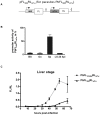Identification and characterization of a liver stage-specific promoter region of the malaria parasite Plasmodium
- PMID: 21048918
- PMCID: PMC2965107
- DOI: 10.1371/journal.pone.0013653
Identification and characterization of a liver stage-specific promoter region of the malaria parasite Plasmodium
Abstract
During the blood meal of a Plasmodium-infected mosquito, 10 to 100 parasites are inoculated into the skin and a proportion of these migrate via the bloodstream to the liver where they infect hepatocytes. The Plasmodium liver stage, despite its clinical silence, represents a highly promising target for antimalarial drug and vaccine approaches. Successfully invaded parasites undergo a massive proliferation in hepatocytes, producing thousands of merozoites that are transported into a blood vessel to infect red blood cells. To successfully develop from the liver stage into infective merozoites, a tight regulation of gene expression is needed. Although this is a very interesting aspect in the biology of Plasmodium, little is known about gene regulation in Plasmodium parasites in general and in the liver stage in particular. We have functionally analyzed a novel promoter region of the rodent parasite Plasmodium berghei that is exclusively active during the liver stage of the parasite. To prove stage-specific activity of the promoter, GFP and luciferase reporter assays have been successfully established, allowing both qualitative and accurate quantitative analysis. To further characterize the promoter region, the transcription start site was mapped by rapid amplification of cDNA ends (5'-RACE). Using promoter truncation experiments and site-directed mutagenesis within potential transcription factor binding sites, we suggest that the minimal promoter contains more than one binding site for the recently identified parasite-specific ApiAP2 transcription factors. The identification of a liver stage-specific promoter in P. berghei confirms that the parasite is able to tightly regulate gene expression during its life cycle. The identified promoter region might now be used to study the biology of the Plasmodium liver stage, which has thus far proven problematic on a molecular level. Stage-specific expression of dominant-negative mutant proteins and overexpression of proteins normally active in other life cycle stages will help to understand the function of the proteins investigated.
Conflict of interest statement
Figures






Similar articles
-
RNA-Seq Analysis Illuminates the Early Stages of Plasmodium Liver Infection.mBio. 2020 Feb 4;11(1):e03234-19. doi: 10.1128/mBio.03234-19. mBio. 2020. PMID: 32019802 Free PMC article.
-
Overexpression of Plasmodium berghei ATG8 by Liver Forms Leads to Cumulative Defects in Organelle Dynamics and to Generation of Noninfectious Merozoites.mBio. 2016 Jun 28;7(3):e00682-16. doi: 10.1128/mBio.00682-16. mBio. 2016. PMID: 27353755 Free PMC article.
-
D-Glucose concentration is the key factor facilitating liver stage maturation of Plasmodium.Parasitol Int. 2014 Aug;63(4):584-90. doi: 10.1016/j.parint.2014.03.004. Epub 2014 Mar 30. Parasitol Int. 2014. PMID: 24691399
-
Same, same but different: Exploring Plasmodium cell division during liver stage development.PLoS Pathog. 2023 Mar 30;19(3):e1011210. doi: 10.1371/journal.ppat.1011210. eCollection 2023 Mar. PLoS Pathog. 2023. PMID: 36996035 Free PMC article. Review.
-
Insights into the early liver stage biology of Plasmodium.J Vector Borne Dis. 2018 Jan-Mar;55(1):9-13. doi: 10.4103/0972-9062.234631. J Vector Borne Dis. 2018. PMID: 29916442 Review.
Cited by
-
A Plasmodium phospholipase is involved in disruption of the liver stage parasitophorous vacuole membrane.PLoS Pathog. 2015 Mar 18;11(3):e1004760. doi: 10.1371/journal.ppat.1004760. eCollection 2015 Mar. PLoS Pathog. 2015. PMID: 25786000 Free PMC article.
-
Transcriptome analysis of Plasmodium berghei during exo-erythrocytic development.Malar J. 2019 Sep 24;18(1):330. doi: 10.1186/s12936-019-2968-7. Malar J. 2019. PMID: 31551073 Free PMC article.
-
Shedding of host autophagic proteins from the parasitophorous vacuolar membrane of Plasmodium berghei.Sci Rep. 2017 May 19;7(1):2191. doi: 10.1038/s41598-017-02156-7. Sci Rep. 2017. PMID: 28526861 Free PMC article.
-
Features of autophagic cell death in Plasmodium liver-stage parasites.Autophagy. 2013 Apr;9(4):568-80. doi: 10.4161/auto.23689. Epub 2013 Feb 6. Autophagy. 2013. PMID: 23388496 Free PMC article.
-
Enlightening the malaria parasite life cycle: bioluminescent Plasmodium in fundamental and applied research.Front Microbiol. 2015 May 11;6:391. doi: 10.3389/fmicb.2015.00391. eCollection 2015. Front Microbiol. 2015. PMID: 26029172 Free PMC article. Review.
References
-
- Vanderberg JP. Plasmodium berghei: quantitation of sporozoites injected by mosquitoes feeding on a rodent host. Exp Parasitol. 1977;42:169–181. - PubMed
-
- Yuda M, Iwanaga S, Shigenobu S, Mair GR, Janse CJ, et al. Identification of a transcription factor in the mosquito-invasive stage of malaria parasites. Mol Microbiol. 2009;71:1402–1414. - PubMed
Publication types
MeSH terms
Substances
LinkOut - more resources
Full Text Sources
Other Literature Sources

